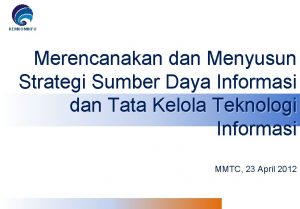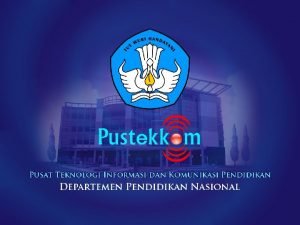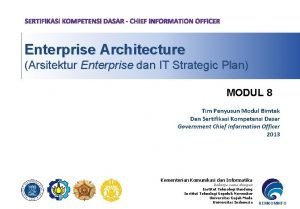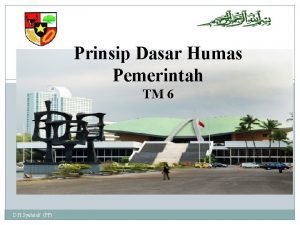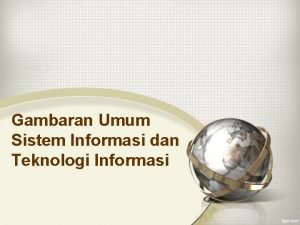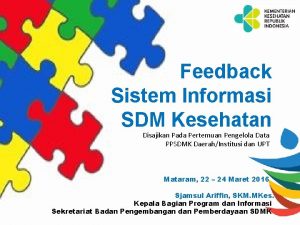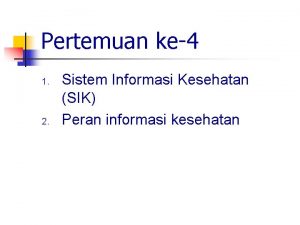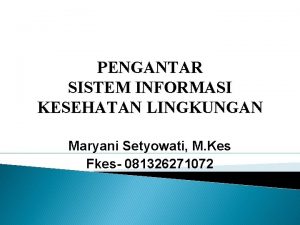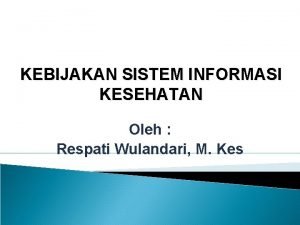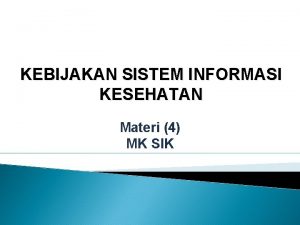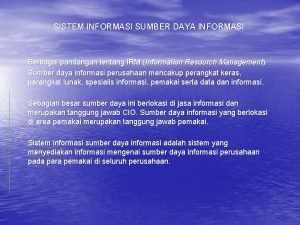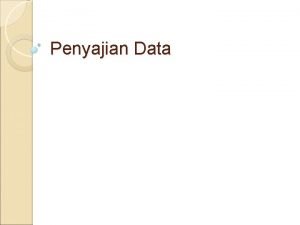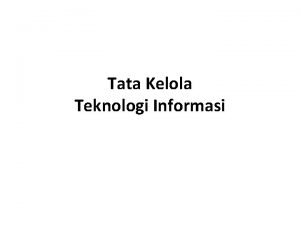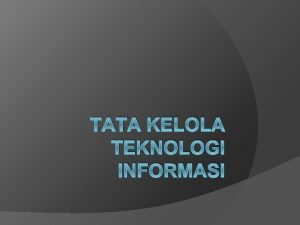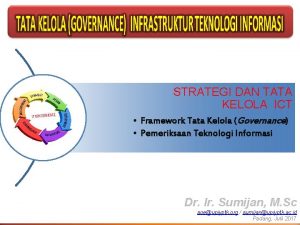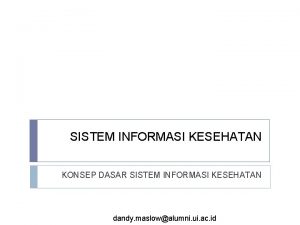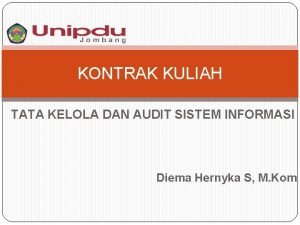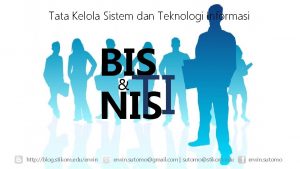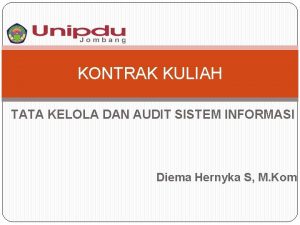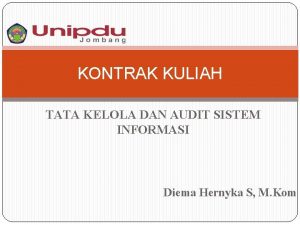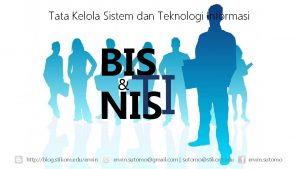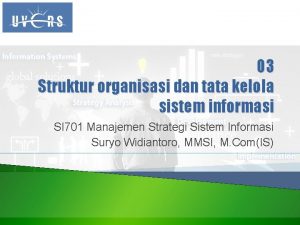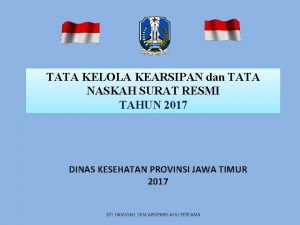TATA KELOLA SISTEM INFORMASI DAN KESEHATAN PERTEMUAN Ke
















- Slides: 16

TATA KELOLA SISTEM INFORMASI DAN KESEHATAN PERTEMUAN Ke – 12 Manajemen Informasi Kesehatan Fakultas Ilmu Kesehatan

Learning Objectives • Describe a justification for government intervention in business processes. • List five major types of government intervention into healthcare business, and explain the need for government to invest in healthcare information management/information technology (IM/IT). • Describe the eight components of the administrative simplification portion of the Health Insurance Portability and Accountability Act. • Assess your organization’s readiness for transactions and code set development. • Analyze why privacy and security are important and why IM/IT has a key role in protecting privacy and security. • Assess four key questions to answer in developing privacy policies. • Describe IM/IT leadership’s role in responding to legislation.

Government’s Role in Healthcare IM / IT • Three questions must be asked in assessing the role of government in healthcare IM/IT: – Why does the government (at any level) get involved in regulating healthcare or any business practice? Is there justification for government intervention? – If yes, how much and what types of interventions are justified? – What triggers those interventions?

Justification for Government Intervention

Government Intervention in the Healthcare Field For most industries, the government largely allows the market to determine costs, efficiency, quality, availability, and firm survival. With the exception of enforcing property rights and legal contracts, the government’s role is minor. Healthcare is different from other industries, however. The government gets involved in healthcare and, by extension, healthcare IM / IT, because the government has a broad obligation to protect the health and welfare of the population. That obligation extends beyond ensuring that markets function and property rights are enforced (Feldstein 2001). Finding that the health of the population is at risk makes intervention to improve patient safety vital. Evidence that this risk is real comes from a series of prestigious Institute of Medicine studies.

Government and Business Practice • Good business practice dictates that much of what come sunder the guise of government intervention should be followed irrespective of the regulations. • Without a direct government role, healthcare organizations will adopt technology slowly and in a haphazard fashion. Blumenthal (2006) provides three business arguments justifying government intervention. – First, no compelling business case exists for investment in health information technology – Second, for real system benefits to be seen, all components of the fragmented U. S. healthcare delivery system must participate. – Third, fraud and abuse regulations do not allow physicians to receive subsidies from hospitals

Health Insurance Portability and Accountability Act HIPAA The Administrative Simplification provisions of the Health Insurance Portability and Accountability Act of 1996 (HIPAA, Title II) required the Department of Health and Human Services (HHS) to establish national standards for electronic healthcare transactions and national identifiers for providers, health plans, and employers. It also addressed the security and privacy of health data. As the industry adopts these standards for the efficiency and effectiveness of the nation’s healthcare system will improve the use of electronic data interchange. (CMS 2005 a)

Cont. • The electronic medium also raised concerns with security and privacy that the government felt it should address. In simple terms, administrative simplification had five elements (CMS 2005 b): – – – Standards Provider and health plan mandate Privacy Preemption of state law Penalties

Eight Major Components of HIPAA Administrative Simplification Provisions • • Employer identifier standard Enforcement National provider identifier standard Security standard Transaction and code sets standard Place of service codes for HIPAA transactions Health insurancere form for consumers (HIPAATitle. I) Medicaid HIPAA administrative simplification

The Need for Information Privacy and Security Consequently, clinical information systems require comprehensive programs to protect the privacy of patient medical records. The following three categories of clinical systems must be considered: • Patient care systems (order entry and results reporting; electronic medical records; lab, pharmacy, radiology; etc. ) store information about a patient’s medical history, diagnoses, and treatment plans. Organizations that provide care required by law and by ethical considerations to ensure that patient-specific information is available only to authorized users.

Cont. • • Public health information systems support disease prevention and surveillance programs. Protecting public health requires the acquisition and storage of health-related information about individuals. Public health benefits sometimes conflict with threats to individual privacy. Breaches of privacy of sensitive information can potentially lead to discrimination in employment or insurance eligibility. Individuals concerned about privacy who avoid clinical tests and treatments may endanger the health of others in the community. For example, sexually transmitted infections can be spread by failure to test and/or report the presence of the infections in certain patients. Medical research information systems use large repositories of individual patient records to study patterns of health and disease in populations. Datamining techniques are used to search for potential relationships among patient characteristics and other factors. Research data often are accessible to a number of investigators and their staff, and information security measures are essential to protect patient privacy rights.

Cont. They also report a number of common elements important for others to consider in the development of privacy policies across organizational entities, including the following: • Privacy policies are local. • Organizations participating in the RHIO will influence the privacy policies. • Privacy policies need to be developed early and revisited often. • Work on privacy policies is ongoing. • Privacy policies are unique to the environment; thus, there are not yet best practices to follow. • Building consensus on privacy policies takes time. • The consumer role in privacy policy development is limited

Healthcare IM / IT Leadership Roles • • Determine breadth and scope of impending or actual legislation Assess current organizational readiness for impact Perform gap analysis within the organization Recommend strategies to meet legal/regulatory changes – Develop staffing and critical expertise needed to address changes – Specify hardware and software needs – Estimate total financial implications of recommendations • Identify clinical and other resources within the organization that will be necessary in meeting standards • Outline timeline for implementation with key dates and milestones

Protecting Information Privacy and Confidentiality • Access rights—who has access and for what reasons • Release of information to the patient, other healthcare providers, and third parties • Special handling, if any, for specific information (e. g. , HIV results, psychiatric notes) • Special handling, if any, for particular patients (e. g. , employees or VIPs) • Availability of medical information, including retention policies • Integrity of medical information, including authentication, completeness, and handling of revisions or addenda • Approved methods for communication of medical information

Summary The chapter presents three major ideas. First, it presents and explores government’s role in healthcare IM/IT. There is a justification for governmental intervention in business processes if markets fail in their role of allocating scarce resources. Understanding why government gets involved will assist the reader in responding to legislation and anticipating future actions. In healthcare, there are compelling reasons for the government intervention, including a weak business case for information technology investment by providers, system fragmentation and lack of interoperability, and regulatory restrictions from fraud and abuse standards.

Cont. Second, the chapter explores HIPAA in detail. This major set of government legislative and administrative interventions has fundamentally changed healthcare IM/IT. Passed by the U. S. Congress in 1996, two components of HIPAA have direct impact on healthcare information systems. The administrative simplification provisions of the law are designed to improve efficiency in the healthcare system by establishing uniform, national standards to be used for the electronic transmission of certain financial and administrative transactions. Privacy protection components of HIPAA restrict disclosure of health information to the minimum needed for patient care and administrative support. Patients have gained new rights to access their medical records and to know who has accessed them. HIPAA compliance required that most healthcare organizations and their software vendors make modifications to computer software to meet the data standards and privacy protection provisions of the law. Changes to business processes and procedures were needed as well. Education and training of employees is particularly important.
 Pengertian tata kelola perusahaan
Pengertian tata kelola perusahaan Tata kelola klinis rumah sakit
Tata kelola klinis rumah sakit Tata kelola tik
Tata kelola tik Jardiknas adalah
Jardiknas adalah Tata kelola tik
Tata kelola tik Sebutkan prinsip dasar humas pemerintah
Sebutkan prinsip dasar humas pemerintah Definisi tata kelola perusahaan
Definisi tata kelola perusahaan Gambaran teknologi informasi
Gambaran teknologi informasi Sistem informasi sdm kesehatan
Sistem informasi sdm kesehatan Contoh aplikasi sik
Contoh aplikasi sik Sistem informasi kesehatan lingkungan
Sistem informasi kesehatan lingkungan Kebijakan sistem informasi kesehatan
Kebijakan sistem informasi kesehatan Kebijakan sistem informasi kesehatan
Kebijakan sistem informasi kesehatan Sistem informasi sumber daya informasi
Sistem informasi sumber daya informasi Tugas asisten tenaga kesehatan
Tugas asisten tenaga kesehatan Diagram batang majemuk
Diagram batang majemuk Sel adalah pertemuan antara titik-titik dan titik-titik
Sel adalah pertemuan antara titik-titik dan titik-titik


